January 21, 2020
A Texas congregation caring for immigrants gains a new understanding of Christianity as a ‘trauma-healing movement’

Mayra Zelaya plays with her son Eliel Zelaya during a church service at San Antonio Mennonite Church. Zelaya, a Honduran immigrant, has been in the United States with her family for 14 months. The church is helping her and other migrants and asylum seekers by providing shelter and resources. Photo by Wendi Poole
For the past three years, members of a Mennonite church in San Antonio have welcomed people crossing the U.S.-Mexico border. The experience has changed them and their understanding of the gospel.
Around the beginning of Advent in December 2016, a small church in downtown San Antonio, Texas, was transformed into a live-action nativity scene. The drama was unplanned, and it was not make-believe: pilgrimming people were seeking shelter, and San Antonio Mennonite Church became an inn.
Over the course of a long weekend, U.S. Immigration and Customs Enforcement buses unloaded scores of women, men and children who had been released without warning from detention centers along the U.S.-Mexico border.
“We had ICE buses just pulling up, right out front, and letting people off. It was days of bus after bus,” said the Rev. John Garland, the 38-year-old pastor of San Antonio Mennonite Church.
At the peak, about 500 people crammed into the church. The building looms large over its corner lot thanks to a high sanctuary ceiling and bell tower, but it is narrowly constructed and can feel full with just a few dozen people on Sunday mornings. On this weekend, people squeezed into every square inch — pews, altar, fellowship hall.

The surge subsided over the course of several days, but as the congregation put the building back in order, they realized that something had changed.
Garland said they weren’t sure what to do next, but they had a core conviction: “It’s our building, but it’s not really our building. We’re going to offer it back to God.”
Garland was speaking literally — the church houses pro bono lawyers and other struggling nonprofit groups within its space. But he also was speaking figuratively; ever since that December, the church has funneled resources of all kinds into the care of the migrants and asylum-seekers who pass through San Antonio daily.
The approach to this ministry is necessarily shape shifting; it’s less a fine-tuned system and more a state of mind, a fixed but flexible commitment to respond to needs that are both constant and constantly changing.
The volume of families who get across the border and are released into the United States varies from month to month or even from day to day, depending on a range of factors: the time of year, the weather in Mexico, federal and city policy changes, and more.
But most weeks, anywhere from a few dozen to a few hundred recently arrived families show up in San Antonio and need a night or two of safety, quiet and rest — plus food, a change of clothes, and perhaps help navigating medical and legal issues, as well as planning for the next stage of their journey.
What are your organization’s core convictions?
San Antonio Mennonite volunteers do not ask about legal status but presume that virtually all the new arrivals are asylum seekers.
The congregation tries to make a long-term difference in people’s lives by employing an approach called trauma-informed care, which draws on the behavioral sciences to help people heal from the ways that traumatic experiences can shape the brain, producing certain modes of belief and action.
The primary intent when working with traumatized people, Garland said, is to offer “a nonanxious presence.” He explains the practices to volunteers and to the travelers themselves, in hopes that they will absorb healing techniques they can take with them as they journey on.
“Many are moving into situations where they will be surrounded by more traumatized people,” he said. “So they can pick up some tools that they can use for themselves and others.”
All this reflection has come to imbue not just the migrant care ministry but also the way the gospel is presented at the church.
“You realize — this is what the Bible is about!” Garland said. “Christianity is a trauma-healing movement.”
Welcoming the future leaders of the church
San Antonio Mennonite Church is affiliated with Mennonite Church USA, a denomination that is Anabaptist in theology and practice.
Mitzi Moore, a longtime member of the congregation, said that what’s crucial to her about Mennonite faith involves a commitment to the practical work of peacemaking, or reconciliation, working on behalf of vulnerable people.
As Garland puts it, quoting the Anabaptist theologian Palmer Becker, “Jesus is the center of our faith, community is the center of our lives, and reconciliation is the center of our work.”
San Antonio Mennonite Church among 2019 winners
Leadership Education at Duke Divinity recognizes institutions that act creatively in the face of challenges while remaining faithful to their mission and convictions. Winners receive $10,000 to continue their work.
At Sunday services, this is visible as the congregation blends socioeconomic classes and ethnicities, from longtime Texan congregants to just-arrived, passing-through families from countries such as Honduras, Guatemala, El Salvador, Haiti or even the Democratic Republic of Congo, which saw 300,000 people flee ethnic violence this summer, many of whom made their way to the southern U.S. border.
Most of these congregants are temporary; their names and faces change from week to week as they pass through the city.
“On any given Sunday morning,” congregant Nick Garcia said, “maybe a quarter are the folks who have not always been there. Then there’s another big percentage that are there because of what [the church] is doing.”
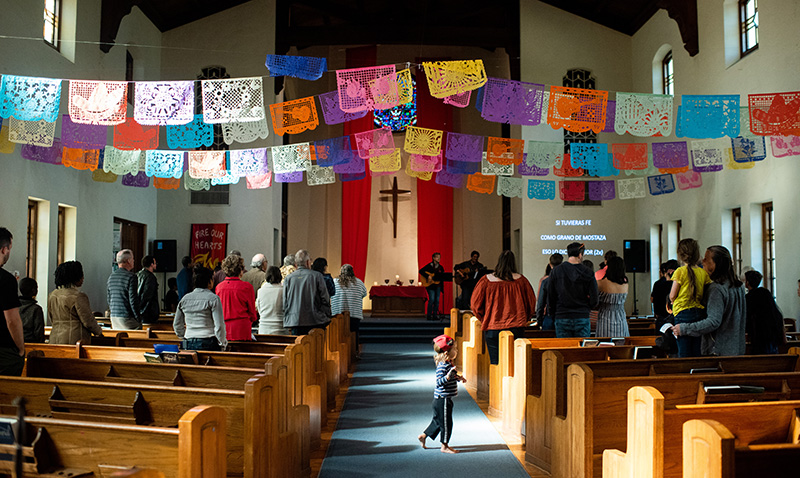
He said that for his part, he’s always looking for ways for the congregation to become even more welcoming and “to bring more of the voices of immigrants into the life of the church.”
Depending on the makeup of the congregation on Sundays, the songs, preaching and announcements are delivered in a mix of Spanish and English.
Then there’s the even more literal work of reconciliation: reuniting families that have become separated from each other, either by the travails of a country-crossing journey or by U.S. officials at the border.
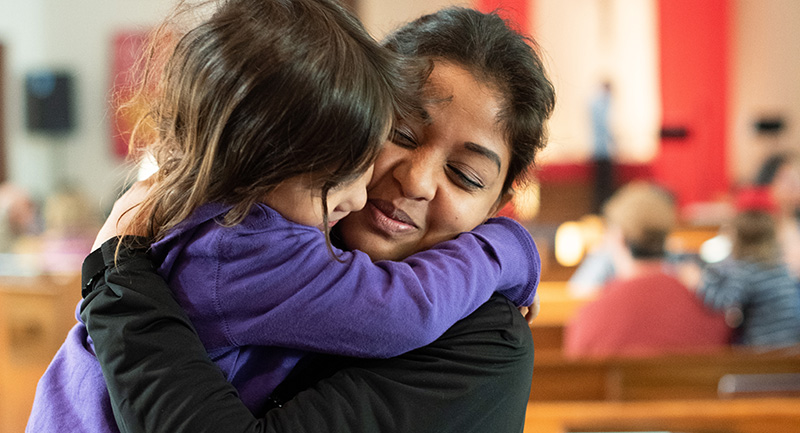
At a temporary shelter called La Casa de Maria y Marta, a couple of blocks from the building, the church houses families who just need a night or two in town.
Families who require a longer stay may be housed a few miles south on a small ranch that offers a couple of multibedroom trailer homes.
Pending funding, the church’s plans also call for a hostel-like facility that could host more families and that would include an on-site counselor and access to legal help.
What is at the center of your organization’s work?
When the work pays off, Sunday services include stories of family reunification.
In fall 2018, a woman from Honduras named Dolores arrived at La Casa. (Her name has been changed to protect her identity.) Dolores is a mother of four who had been separated from one of her children, a 15-year-old girl, at the border.
Her youngest boy was still with her, but her two other boys had stayed behind in Honduras. Later, one was killed by a cartel member. The other, a 10-year-old, decided to make his way north with his uncle, ultimately crossing the border alone.
“Yo llegué a La Casa María y Marta como una gallina comprarado,” Dolores said. I arrived at La Casa de Maria y Marta like a bought hen. Garland, translating for Dolores, said she described herself as a just-purchased chicken, uncertain of her surroundings, ready to peck at anything.
How adaptive is your organization? Could you quickly respond to a humanitarian crisis?
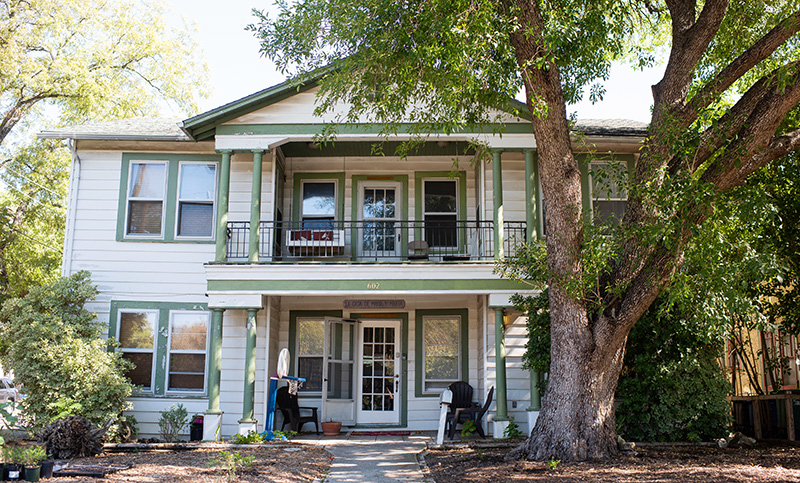
For months, the church worked to help reunite Dolores with her children. Her daughter was held in detention for three months before being released, and her young son was held for a month after his crossing. Each time, Garland accompanied Dolores back to the border, witnessing the mother’s long-awaited embrace of her surviving children.
And each time, Dolores proclaimed that the reunification was the work of a God who had called her into this journey, given her protection and — even in the face of great loss — answered her prayers.
Meanwhile, Dolores began to serve at La Casa de Maria y Marta, the church’s shelter. With Garland translating, she described her work.
“The families that come don’t have much, and a lot has happened to them along the way. They’ve suffered a lot,” she said. “But … they think it’s going to be a lot worse here,” where the setting is unfamiliar, next steps are unclear, and they’re surrounded by mostly white strangers.
Dolores serves them, she said, “as a fellow immigrant, giving them advice, giving them my love, my support, hugging, giving them a lot of love.”
Garland said he watches the stories of the immigrant families unfold as lessons in what it means to have faith, to persevere through great trials and to serve — teaching him and the congregation what it means to be Christian.
“They are better Christians than we are,” he said. “This is the pilgrim church passing through,” and by dint of their growing numbers and their powerful displays of faith, they are also “the future leaders of the church.”
Practicing trauma-informed care
Even when the families manage to cross over and get through processing together, “they are shells when they arrive,” Garland said. “All of them have experienced extreme trauma.”
Some have gone ages without proper nutrition or medical attention, or without washing their bodies or their clothes.
As the congregation has come to know their stories, Garland has introduced trauma-informed practices into the church’s work. In time, Garland hopes trauma-informed care will become an even more explicit aspect of their ministry to recent immigrants, complete with a full-time counselor on-site.
As a framework for dealing with individuals and groups of people, trauma-informed care has for years been a growing trend. From education to criminal justice to professional ministry, caregivers are learning how trauma can produce certain modes of belief and behavior. Trauma-informed practices are designed to take into account the lasting effects of adverse experiences in deciding how to care for people.
Garland came upon trauma-informed care after experiencing trauma himself. He lost his mother to a “terrible, painful death” from pancreatic cancer in 2015. Then, in early 2017, he and his wife, Abby, were involved in a serious traffic accident that left her with several broken ribs and him concussed, with a fractured spine.
Weeks later, well after he’d returned to work, Garland felt like he was “in a trap.”
“I was staring at the wall, not able to parent well or do anything, and not being able to fix it,” he said.
During this time, he was also absorbing the tragic stories of the people coming into the city each day. Trauma studies note the effects of “secondary traumatic stress” from hearing the trauma accounts of others — a hazard for caregivers.
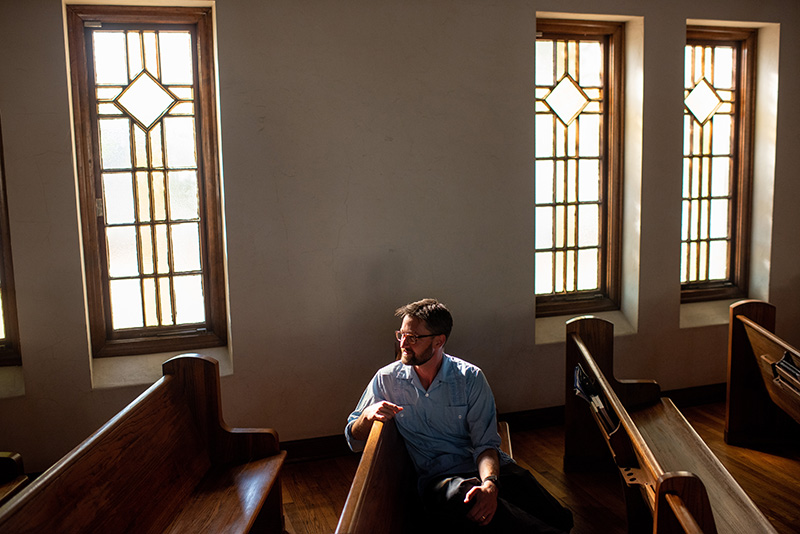
Eventually, Garland began to study trauma-informed therapy by talking to psychologists with whom the church was partnered, reading trauma theologians such as Shelly Rambo and drawing on resources like the American Bible Society’s Trauma Healing Institute.
Over time, he began to incorporate what he was learning into the way San Antonio Mennonite Church worked with the folks coming to them.
When first-time volunteers — whether church congregants or other locals who have heard about the ministry — show up at the shelter, Garland gives them a brief overview.
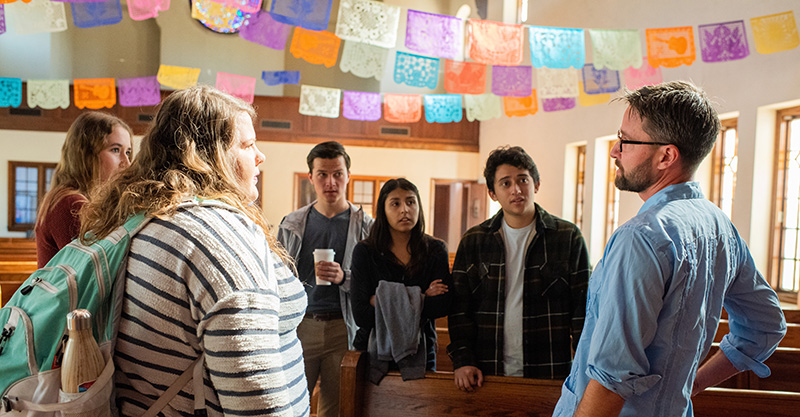
He explains that a person may be traumatized by the absence of good: hunger, extreme poverty. Or a person may be traumatized by the presence of evil: violence, abuse.
“Either way,” said Garland, “trauma will cause you to experience some situations as if you’re in a hole and the hole is filling with water and you’re drowning.”
Living the trauma-healing gospel
Garland stresses precise behaviors to ease fear when working with people who have just crossed the border or been released from detention: “Always remember that when you approach a woman, you’re going to approach them sideways, like this,” he instructs, angling his body perpendicular to the person standing next to him.
“And you’re looking down; … you’re not making direct eye contact. And you’re not going to stand over them, but you’re going to bend down.”
Also: “Never take something out of their hands. Let them hand it to you.”
The work of caring for the folks coming through their city has brought renewed focus and purpose to the members of San Antonio Mennonite Church, both by giving them a mission and by pushing them to be “more grounded and mature” in the faith, Garland said.
This work has also given rise to the church’s growing sense that Christianity itself is a faith and practice designed to heal trauma.
How does your organization approach people? Do you take into consideration what individuals may have experienced prior to approaching them?
“The Christian movement was birthed out of horrific violence. Paul … was always at risk. He describes being beaten severely and jailed unjustly and in shipwrecks, and [he becomes] this person who has dealt with a ton of trauma writing to people who are dealing with trauma.”
Garland has lately preached the Gospel of Mark as a trauma-informed text, reframing key sacraments and symbols in terms of how they touch on trauma: a “public torture instrument hangs in every church,” he said, and each week Christians consume a broken body and poured-out blood.
How might your organization reframe or contextualize symbols that could trigger trauma in those you are serving?
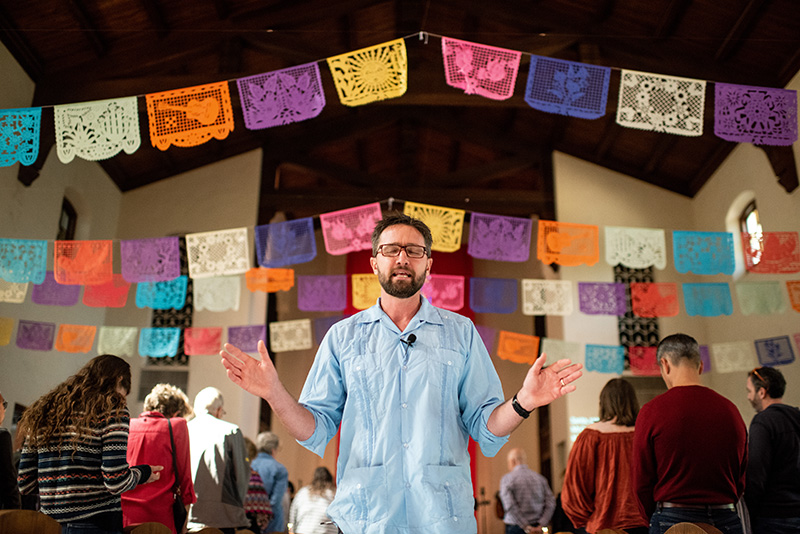
The more we understand the impact of trauma on people, Garland said, and the more we’re reoriented in how we approach them and care for them, the closer we’re getting to the heart of what it means to live the gospel.
“I’ve certainly not suffered like Paul suffered,” he said. “But I work with people who have.”
How to ask new — Christian — questions about immigration
Because of the local visibility of the work of San Antonio Mennonite Church, the Rev. John Garland is often called upon to discuss and debate this topic that has been roiling American political culture, especially since the 2016 election. When he does so, Garland addresses three types of questions about the immigrants crossing into the United States at the southern border.
1. The legal question: Aren’t we a nation of laws? Can’t we defend ourselves against illegal immigration?
2. The fear question: What if the people crossing the border take our jobs? What if they are violent? What if they change our culture?
3. The scarcity question: How are we supposed to take care of these people? Why can’t they take care of themselves?
“These are good questions,” Garland said. “But they are political questions or economic questions or policy questions.
“They are not good Christian questions. And we, as Christians, have to ask really good Christian questions.”
So what are good Christian questions? Garland returns to the three perpetual questions and applies a Christian filter — the filter of the gospel — which transforms them.
Through a Christian filter, the legal question becomes, How are we fulfilling the law to love your neighbor as yourself?
The fear question, which is about “how they are affecting us,” he said, becomes, How is God transforming us and them? How are we all being transformed by the kingdom of God?
And the scarcity question? Well, said Garland, that question could be almost directly lifted from the Gospel accounts of the miraculous feeding with loaves and fishes. “‘How are we supposed to take care of all these people?’ Two times the disciples ask Jesus that exact question,” he said. And in both cases, God expands the available resources to meet the need.
Through a Christian filter, then, the scarcity question shifts to, What is God expanding?
Questions to consider
- The influx of immigrants in 2016 helped clarify San Antonio Mennonite’s core convictions. What are your organization’s core convictions?
- How adaptive is your organization? Could you quickly respond to a humanitarian crisis?
- Anabaptist theologian Palmer Becker says, “Jesus is the center of our faith, community is the center of our lives, and reconciliation is the center of our work.” What is the center of your organization’s work?
- How does your organization approach people? Do you take into consideration what individuals may have experienced prior to approaching them?
- How might your organization reframe or contextualize symbols that could trigger trauma in those you are serving?



Share